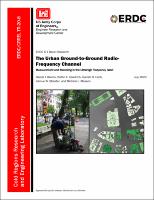Please use this identifier to cite or link to this item:
https://hdl.handle.net/11681/37554Full metadata record
| DC Field | Value | Language |
|---|---|---|
| dc.contributor.author | Breton, Daniel J. | - |
| dc.contributor.author | Haedrich, Caitlin E. | - |
| dc.contributor.author | Hoch, Garrett R. | - |
| dc.contributor.author | Streeter, Samuel S. | - |
| dc.contributor.author | Maxson, Michele L. | - |
| dc.date.accessioned | 2020-07-27T15:46:15Z | - |
| dc.date.available | 2020-07-27T15:46:15Z | - |
| dc.date.issued | 2020-07 | - |
| dc.identifier.govdoc | ERDC/CRREL TR-20-8 | - |
| dc.identifier.uri | https://hdl.handle.net/11681/37554 | - |
| dc.identifier.uri | http://dx.doi.org/10.21079/11681/37554 | - |
| dc.description | Technical Report | - |
| dc.description.abstract | Ground-to-ground radio communication and sensing within the urban environment is challenging because line of sight between transmitter and receiver is rarely available. Therefore, radio links are often critically reliant on reflection and scattering from built structures. Little is known about the scattering strength of different buildings or whether such differences are important to the urban ground-to-ground channel.We tested the hypotheses that (1) diffuse scattering from built structures significantly impacts the urban channel and (2) scattering strength of urban structures varies with surface roughness and materials. We tested these hypotheses by measuring urban channels in Concord, New Hampshire, and Boston, Massachusetts, and via channel-modeling efforts with three-dimensional representations of the urban environment. Direct comparison between measured and modeled channels suggest that both of these hypotheses are true. Further, it appears that ray-tracing approaches underestimate the complexity of urban channels because these approaches lack the physical processes to correctly assess the power incident on and scattered from built structures. We developed a radio-geospatial model that better accounts for incident power on both directly visible and occluded buildings and show that our model predictions compare more favorably with measured channels than those channels predicted via typical ray-tracing approaches. | en_US |
| dc.description.sponsorship | United States. Army. Corps of Engineers. | en_US |
| dc.description.tableofcontents | Abstract ................................................................................................................................................... ii Figures and Tables .................................................................................................................................. v Preface .................................................................................................................................................. viii Acronyms and Abbreviations ................................................................................................................ix 1 Introduction ..................................................................................................................................... 1 1.1 Background ..................................................................................................................... 1 1.2 Objective .......................................................................................................................... 3 1.3 Approach ......................................................................................................................... 4 1.3.1 Urban channel measurements ....................................................................................... 4 1.3.2 Urban channel modeling ................................................................................................ 5 2 Assessment of the Urban Channel in Concord, New Hampshire .............................................. 6 2.1 Methods .......................................................................................................................... 6 2.2 Results ............................................................................................................................. 8 2.2.1 Path loss .......................................................................................................................... 8 2.2.2 Time dispersion ............................................................................................................. 11 2.3 Conclusions ................................................................................................................... 14 2.3.1 Path loss ........................................................................................................................ 14 2.3.2 Time dispersion ............................................................................................................. 14 2.3.3 Small-city ground-to-ground channels ......................................................................... 15 3 Measurement and Analysis of Ground-to-Ground Channels in Boston, Massachusetts ............................................................................................................................. 16 3.1 Radio geospatial analysis ............................................................................................. 16 3.1.1 Horizontal components of bistatic range and delay ................................................... 17 3.1.2 Vertical components of bistatic range and delay ........................................................ 21 3.2 Channel sounding measurements ............................................................................... 23 3.2.1 Methods ......................................................................................................................... 24 3.2.2 Depolarization of the urban radio-frequency channel ................................................ 25 3.2.3 Radio-frequency channels in the urban core .............................................................. 27 3.2.4 Radio-frequency channels adjacent to an urban core ................................................ 30 3.3 Summary ....................................................................................................................... 36 4 Radio-Frequency Channel Modeling .......................................................................................... 38 4.1 Radio-frequency channel modeling with ray tracing ................................................... 39 4.1.1 Short range, one turn (M8) ........................................................................................... 40 4.1.2 Medium range, one turn (M21) .................................................................................... 41 4.1.3 Long range, two turn (M43) .......................................................................................... 42 4.1.4 Summary of ray-tracing results .................................................................................... 43 4.2 Urban covisibility studies with optical ray tracing ....................................................... 43 4.3 Building Raster Urban Channel Estimator (BRUCE): geospatial radio-frequency channel modeling via incident power profiles ........................................... 46 4.3.1 Vertical profiles of radio-frequency power incident on buildings ............................... 46 4.3.2 Total incident power for urban elevation profiles ........................................................ 50 4.3.3 Mapping building-incident and building-scattered power in urban terrain ................ 53 4.3.4 Estimating the Urban Channel for the CRREL Channel Sounder ............................... 57 4.3.5 Comparison of measured and modeled power delay profiles .................................... 58 4.3.6 The constant cross-section assumption ...................................................................... 62 5 Conclusions ................................................................................................................................... 65 References ............................................................................................................................................ 67 Report Documentation Page (SF 298) .............................................................................................. 71 | - |
| dc.format.extent | 83 pages / 4.81 MB | - |
| dc.format.medium | PDF/A | - |
| dc.language.iso | en_US | en_US |
| dc.publisher | Cold Regions Research and Engineering Laboratory (U.S.) | en_US |
| dc.publisher | Engineer Research and Development Center (U.S.) | - |
| dc.relation.ispartofseries | Technical Report (Engineer Research and Development Center (U.S.)) ; no. ERDC/CRREL TR-20-8 | - |
| dc.rights | Approved for Public Release; Distribution is Unlimited | - |
| dc.source | This Digital Resource was created in Microsoft Word and Adobe Acrobat | - |
| dc.subject | Buildings | en_US |
| dc.subject | Cities and towns | en_US |
| dc.subject | Diffuse | en_US |
| dc.subject | Model | en_US |
| dc.subject | Propagation | en_US |
| dc.subject | Radio frequency | en_US |
| dc.subject | Radio measurements | en_US |
| dc.subject | Scattering | en_US |
| dc.subject | Ultrahigh-frequency | en_US |
| dc.subject | Urban | en_US |
| dc.title | The urban ground-to-ground radio-frequency channel : measurement and modeling in the ultrahigh frequency band | en_US |
| dc.type | Report | en_US |
| Appears in Collections: | Technical Report | |
Files in This Item:
| File | Description | Size | Format | |
|---|---|---|---|---|
| ERDC-CRREL TR-20-8.pdf | 4.81 MB | Adobe PDF |  View/Open |